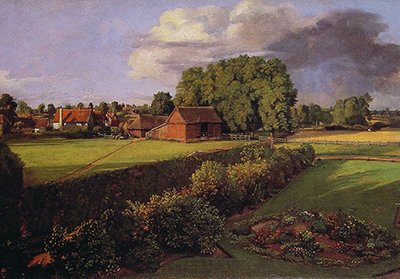When words like 'Romanticism', 'rebel', and 'avant-garde' come to mind, one would hardly think of John Constable's landscape paintings as prime examples, but the artist's unique philosophy on art carries trademark staples that can be seen in most of his works. Golding Constable's Flower garden captures the view from John Constable's family home in Suffolk, England.
His father's garden, which the painting is named after, occupies the bottom and right parts of the painting; a small village and a picturesque sky take up the top and left parts. At the time, the artists of Romanticism focused on epic and fantastical depictions of history or imagination. While the era's current art tries to pull the viewer into another world, Constable seeks to draw attention to the everyday scenery of his birthplace. Although he has the option to produce more commercially popular art, he stays true to his artistic goals and credits any achieved success to the beauty of his family's lands.
The oil on canvas painting features John Constable's signature impasto technique - thick layers of paint applied to a brush or painting knife, which produce a full, solid texture on the canvas. This style leaves the brush or knife strokes plainly visible; the artist's force of application is preserved in the paint. When dried, the thick layers form minor protrusions and give the piece a slight three-dimensional effect. The choice of subjects the artwork displays is unusual for the period. He chooses fields, trees and farmlands in stark opposition of the lush jungles, wild storms, and bottomless seas so commonly associated with Romanticism paintings. Constable's style praises the scenery of nature, but also embraces the element of human interaction.
The painting is currently stored in the Ipswich Museum. "I should paint my own places best," Constable writes to a friend in one of his letters. This sentence is the core of the artist's ideals, as he believes himself to be limited not by his painting ability, but by the nostalgia he holds for his birthplace. Throughout his career, he shows that he considers any feat of fantasy inferior to the tangible scenery of a place that is nowadays called Constable country. The artist holds great love and admiration for his home, and in his own own words: "Painting is but another word for feeling."




